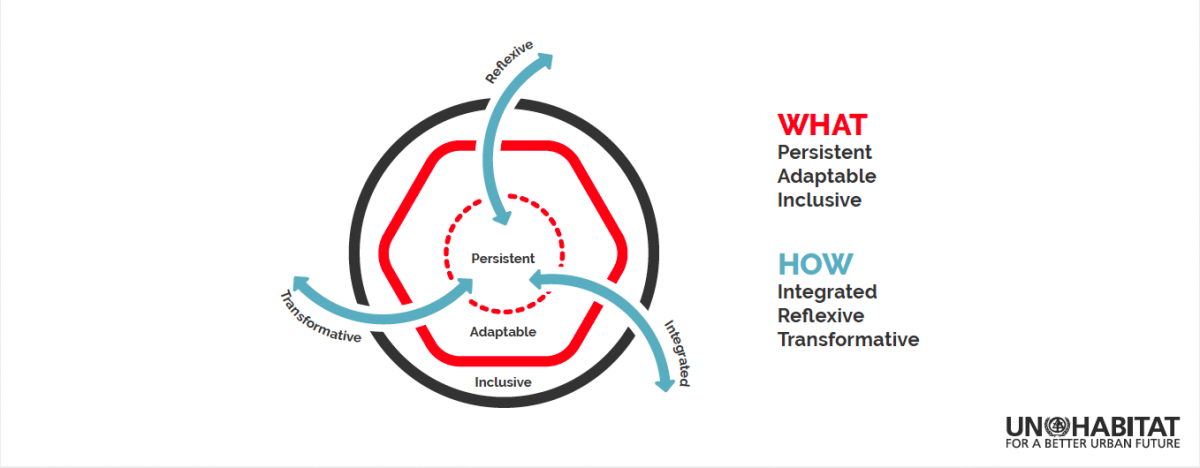17. 01. 2018
MEASURING AND MANAGING ARE IMPORTANT, BUT DEFINING URBAN RESILIENCE MUST COME FIRST
BY Hélène Fournière, Giovanni Pagani and Craig Laird - UN-Habitat
The old and somewhat outdated business motto says, if you can’t measure it, you can’t manage it. But what if you can’t define it? Can cities begin to measure or manage urban resilience without a baseline understanding or characteristics?
Over the past two decades, the urban agenda and the importance of ‘getting it right’ in our cities has been taken up by the international development community. From global organizations to grassroots initiatives and governments on all levels, there is a strong feeling that it is in our cities that we have the biggest opportunity to reach the most people, and with the greatest impact. What’s more, sustainable urban development has benefits well beyond city limits and can improve the wellbeing of those in, around and beyond the urban environment. The RESCCUE project is an example of a consortium of actors working together to achieve this vision through synergies and collaboration.
Resilience is at the forefront of the push to ‘get it right’: achieving sustainable urban development not only because shifting global populations brings new challenges, but also because the effects of new and magnified threats are increasingly being felt in cities. Urban resilience is one of the core principles of sustainable urban development in the post Millennium Development Goals framework, in the Agenda 2030 for Sustainable Development, and across five major global frameworks, including the New Urban Agenda.
For those local governments already struggling with climate change, rapid urbanization and resource scarcity, continually shifting goal posts can be disheartening and hugely detrimental. There is therefore a strong call from city-level actors for a clear yet inclusive understanding of what resilience means for them, and how it can be characterized in their urban contexts. A range of actors have taken up the challenge to build urban resilience, among them and from within the United Nations system, UN-Habitat has developed tools and guidance on building resilience and an inclusive understanding that serves as an umbrella for these efforts.
Defining resilience is not however straightforward. Resilience offers crucial convergence points between different yet essentially similar paradigms in urban development: being resilient means working towards long-term and sustainable impact, while being sustainable means incorporating resilience to protect these same gains. Resilience also lies at the core of the humanitarian-development nexus, bridging together too often disparate agendas: resilience-thinking reduces risks by increasing capacities and addressing vulnerabilities, and enhances effective and forward-thinking response. UN-Habitat has therefore adopted a characteristic-based approach to defining urban resilience. The value of this approach is that it does not exempt vulnerable cities from identifying with certain characteristics and allows them to set realistic target.
As well as providing an inclusive understanding, these characteristics support a holistic approach to urban systems and to resilience-oriented actions that address all shocks and stresses. An abbreviated list of these characteristics can be found below but they are articulated through the WHAT (first three) being resilient means, and HOW (latter three) it can be achieved. Based on these characteristics and by way of a working definition that can lead to better measuring and managing, “UN-Habitat understands urban resilience as the ability of any urban system, with its inhabitants, to maintain continuity through all shocks and stresses, while positively adapting and transforming toward sustainability.” As a member of the consortium of the RESCCUE project, UN-Habitat is bringing this definition together with the characteristics to the work being carried out in order to enable a more holistic diagnosis for the 3 cities.
For more information on the above characteristics and other resilience work, you can visit the Urban Resilience Hub by UN-Habitat that will be launched on February 10th on the occasion of the 9th World Urban Forum. The Hub is intended as an open online space for partners, stakeholders, practitioners, academics, scientists and activists, and we strongly encourage you to visit it.
A Persistent city prepares for current and future shocks and stresses. It builds robustness to withstand disturbances and generates spare capacity across networks and services in case of disruption.
An Adaptable city diversifies its urban services, functions and processes; disposing of enough flexibility to face changing circumstances and to proactively turn challenges into opportunities.
An Inclusive city provides its inhabitants with equal representation and access to opportunities – particularly focusing on marginalized groups and people in vulnerable situations – fostering social cohesion and guaranteeing the fulfilment of human rights.
An Integrated city acknowledges that it is composed by indivisible, interdependent and interacting systems. As such, it promotes policies that enhance communication, collaboration and coordination across sectors; guaranteeing far-reaching and durable change.
A Reflexive city understands that its urban system and surroundings are continuously changing. It learns from the past and it is aware of how previous trends inform its current processes; yet it recognizes the potential to transform through shocks and stresses. A reflexive city also learns by doing and installs mechanisms to iteratively examine progress, as well as systematically update and improve structures.
A Transformative city adopts a proactive approach to building resilience in order to generate positive change. It pursues forward-looking, innovative solutions to create a system that over time is no longer prone to risk.

